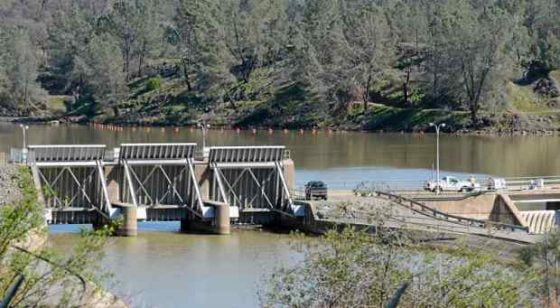
If you have yet to prepare for a “lights out” situation, you had better start. Reports are coming out now that a power plant in California could be temporarily shut down as a result of the drought plaguing the state.
According to a report by Newsweek, if California’s Lake Oroville shrinks below 640 feet, the low water levels may “force” officials to close down a major state power plant for the first time. The reservoir may reach the benchmark as early as late August, adding additional stress to California’s electrical infrastructure during the hottest weather of the season. The Associated Press reported that Lake Oroville helps irrigate about 25% of crops in the U.S. annually, in addition to playing key roles in Northern California tourism and endangered salmon conservation. A severe state drought is evaporating the water supply quicker than usual, leading officials to anticipate record low levels in the lake.
The drought could lead to massive power outages and a decrease in the food supply. This one could end up being a big deal. If you live in that area, the time to prepare was a year ago, but you could still have time. Figure out a way to store food and water.
Jay Lund, co-director of the Center for Watershed Sciences at the University of California-Davis, said that the approximately 1,500 reservoirs in California have fallen 50% lower than expected for this time of year. Trees along the Lake Oroville banks are blackened from the lack of water, while some houseboats sat atop cinderblocks over Memorial Day weekend.
All signs point to this summer, fall, and winter being overall difficult, especially for those who are unprepared and not expecting things to become so dire.
What we need to pay attention to is the one emotion the mainstream media talking heads and the ruling class needs us to feel: fear.
In Northern California’s Butte County, low water prompts another emotion: fear. The county suffered the deadliest U.S. wildfire in a century in 2018 when 85 people died. Last year, another 16 people died in a wildfire. –Newsweek
That’s the name of the game right now and people who are panicked and scared will do things that the calm rational people will not. Focus on your preps and your discernment. Do not allow anyone to put you in a state of fear. Prepare and eradicate that emotion for good.










Lake Mead is almost down to where they won’t be able to generate power also. Yet Vegas etc. continue to build like no tomorrow. Same here, emergency drought and building like crazy to supply the masses. This is not going to end well. Between the drought and the fires it will be scorched earth. All thanks to the massive population of idiots…..
Even though there are high population centers and naturally dry areas that are short of water, technically speaking, there’s no such thing as a water shortage, if people are willing to pay much higher rates. The amount of rain that fails on the earth’s surface in a year is at least 200 to 400 times more than humanity uses in a year. So in a way, one can say there is not a water shortage, but a public works problem. For example, where I live (SE coast of US) we get a great deal of regular rain, but within 2 hours most of the rain has runoff back in the ocean. The county I live is semi-rural, and about 300 square miles. There are 640 acres in a square mile, so my county has about 192,000 acres. One inch rains are common, one inch of rain on one acre is 27,154 gallons. So, when my county receives one inch of rain that’s 5.21 billion gallons of water that has fallen on the county. Yet, within 2 hours 90% is back in the ocean. Reservoirs, water retaining areas, artificial lakes, all kinds of public works projects can be built to hold vast amounts of water. The real expensive part would be the infrastructure to transport it over distances. But if the cost could be justified, enough water could be collected and transported for domestic and agricultural use across the US. Just as there is a highway system, a national water collection and distribution network could be built. The land requirements for these projects would not be that much either. Water collection areas could be also be turned into permanent nature reserves and parks with large natural buffers around them. It’s not a question of technical possibility, it’s an economic and public policy question.
I am a realistic person though, nothing will happen. The gov’t is only good for f*cking people over, they never truly fix anything. All it cares about is acquiring and maintaining power. In fact gov’t always manages to make things worse. Therefore, I rationally expect everything to only get worse and worse until the country is unlivable.
This is all Cal Water resources fault draining the water to the sea. Saving the ” whatever”. https://wattsupwiththat.com/2021/06/13/facing-dry-year-ca-state-water-board-is-draining-california-reservoirs/.
Gray says, “The State Water Board claims it needs the water to help restore fish populations, but an earlier version of their own report suggested their plan would result in little more than an additional 1,000 fish per year.”
Anyone interested in aquaponics can buy 1,000 baby fish in a plastic bag, or there are countless possible alternatives, to preserve nature for the benefit of mankind.
Rather than making plenty of what is useful and good, there will be artificial scarcity.
Thanks Mac.
There’s only one way to solve this: More electric vehicles.
Watch California demand them.
That’s sarcasm isn’t it…
The first sentence is, the second sentence is a prediction based on the reality of California.
We know. Sit down.
Rivers feeding the reservoirs were put back on their natural courses, and the power grids are incentivized not to operate at full capacity, on a credit system. Laws were passed undemocratically, without so much as the radical vote, to cause the system to fail.
There is no firm reason why many industries were necessarily shuttered. Classic landmarks were never necessarily boycotted or ignored out of existence, were it not for some plutocrat or ambulance chaser.
That’s bad news. The more you rely on solar and wind to run your grid the worse the blackouts will be. They are way too intermittent to count on. Only if you have an equal amount of storage for the kws created by the renewables will it work. Storage like excess hydropower reservoirs or batteries or maybe off peak pumped storage. Otherwise you need enough power plants to fill in the gaps. This means gas turbines that can spin up fast from idling and not a cold start. This means you need to actually have two systems running to operate the grid instead of one. Lots of money tied up in both.
Loss of hydropower means brownouts or blackouts because the renewables cannot run the grid alone. Texas has a similar problem.
They sued the power company over fires, and won. What did they expect?
Make electricity, without one interconnected grid. Why should people with grid-tied solar cells still suffer from brownouts.
Or, if you are more state-services-oriented, insulate the wires, and provide adequate infrastructure, seeing as how the govt is the majority shareholder and you are too-big-to-fail.
Where livingspace absolutely cannot be provided (of this, I am skeptical) follow the last several rounds of deportation, in which birthright citizenship was not an issue. Make the majority demographic the quota case of choice, if you are capable of voting yourself largess.